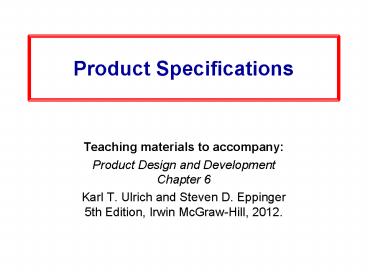Product Specifications - PowerPoint PPT Presentation
Title:
Product Specifications
Description:
... -offs Perceptual Mapping Exercise Chocolate Crunch Hershey s w/ Almonds Hershey s Milk Chocolate Nestl Crunch KitKat Opportunity? – PowerPoint PPT presentation
Number of Views:296
Avg rating:3.0/5.0
Title: Product Specifications
1
Product Specifications
- Teaching materials to accompany
- Product Design and DevelopmentChapter 6
- Karl T. Ulrich and Steven D. Eppinger5th
Edition, Irwin McGraw-Hill, 2012.
2
Product Design and DevelopmentKarl T. Ulrich and
Steven D. Eppinger5th edition, Irwin
McGraw-Hill, 2012.
- Chapter Table of Contents
- Introduction
- Development Processes and Organizations
- Opportunity Identification
- Product Planning
- Identifying Customer Needs
- Product Specifications
- Concept Generation
- Concept Selection
- Concept Testing
- Product Architecture
- Industrial Design
- Design for Environment
- Design for Manufacturing
- Prototyping
- Robust Design
- Patents and Intellectual Property
- Product Development Economics
- Managing Projects
3
Concept Development Process
Mission Statement
Development Plan
Identify Customer Needs
Establish Target Specifications
Generate Product Concepts
Select Product Concept(s)
Set Final Specifications
Plan Downstream Development
Test Product Concept(s)
Perform Economic Analysis
Benchmark Competitive Products
Build and Test Models and Prototypes
Target Specs Based on customer needs and
benchmarking
Final Specs Based on selected concept,
feasibility, models, testing, and trade-offs
4
Outline
- Nature of specifications
- Spec vs. specs.
- Target vs. final specs.
- Process for setting target specs
- Process for setting final specs
5
Spec vs. Specs
- A spec consists of a metric, a unit, and a value
- Specs has a set of specs.
6
Target vs. Final Specs
- Target specs the hope and aspiration of the
design (ideal and marginal) - Refined specs trade-offs among different desired
characteristics. - Intermediate specs
- Final specs
- It is in the projects contract book
7
Nature of Specifications
- The reference point for functionality design and
quality planning - A product assembly usually requires a hierarchy
of specs, for the final product and each of its
components
8
The Product Specs Process
- Set Target Specifications
- Based on customer needs and benchmarks
- Develop metrics for each need
- Set ideal and acceptable values
- Refine Specifications
- Based on selected concept and feasibility testing
- Technical and economic modeling
- Trade-offs are critical
- Reflect on the Results and the Process
- Critical for ongoing improvement
9
Procedure for establishing target specifications
- Identify a list of metrics and measurement units
that sufficiently address the needs - Collect the competitive benchmarking information
- Set ideal and marginally acceptable target values
for each metric (using at least, at most,
between, exactly, etc.) - Reflect on the results and the process
10
Process for setting the final specifications
- Develop technical models to assess technical
feasibility. The input is design variable and
the output is a measurement using a metric. - Develop a cost model of the product.
- Refine the specifications, making tradeoffs,
where necessary to form a competitive map. - Flow down the final overall specs to specs for
each subsystem (component and part). - Reflect on the results to see
- Whether the product is a winner, and/or
- How much uncertainty there is in the technical
and cost model, or - Whether there is a need to develop a better
technical model.
11
(No Transcript)
12
Product Specifications ExampleMountain Bike
Suspension Fork
13
Start with the Customer Needs
14
Metrics Exercise Ball Point Pen
- Customer NeedThe pen writes smoothly.
15
Establish Metrics and Units
16
Link Metrics to Needs
17
Benchmark on Customer Needs
18
Benchmark on Metrics
19
Assign Marginal and Ideal Values
20
Concept Development Process
Mission Statement
Development Plan
Identify Customer Needs
Establish Target Specifications
Generate Product Concepts
Select Product Concept(s)
Set Final Specifications
Plan Downstream Development
Test Product Concept(s)
Perform Economic Analysis
Benchmark Competitive Products
Build and Test Models and Prototypes
Target Specs Based on customer needs and
benchmarking
Final Specs Based on selected concept,
feasibility, models, testing, and trade-offs
21
Perceptual Mapping Exercise
Opportunity?
22
(No Transcript)
23
(No Transcript)
24
Specification Trade-offs
Estimated Manufacturing Cost ()
Score on Monster (Gs)
25
Set Final Specifications
26
Quality Function Deployment(House of Quality)
technical correlations
relative importance
engineering metrics
benchmarking on needs
customer needs
relationships between customer needs
and engineering metrics
target and final specs
27
(No Transcript)
28
Profit margin
- Where
- M profit margin
- P price
- C cost
29
Target Cost
- Where
- C target cost
- P price to the end user
- Mi the margin at the ith stage.
30
Mark up
- Markup P/C - 1
- Where
- P price
- C cost
31
(No Transcript)
32
Chapter 6 HW
- Metric Exercise Ball Point Pen
- Identify five possible metrics and the unit of
measure for a customer need as stated below - The pen writes smoothly.































